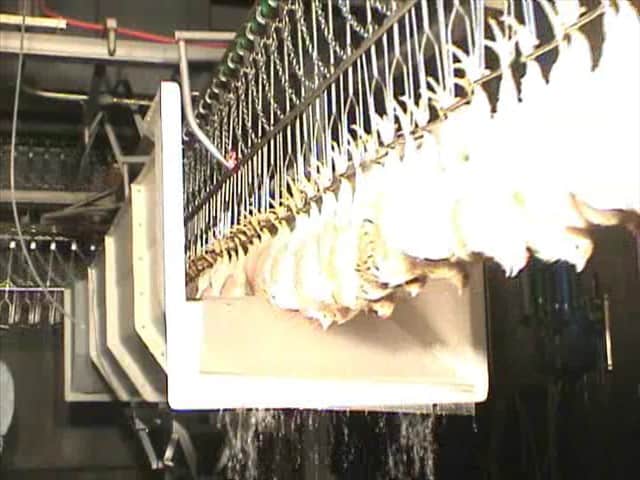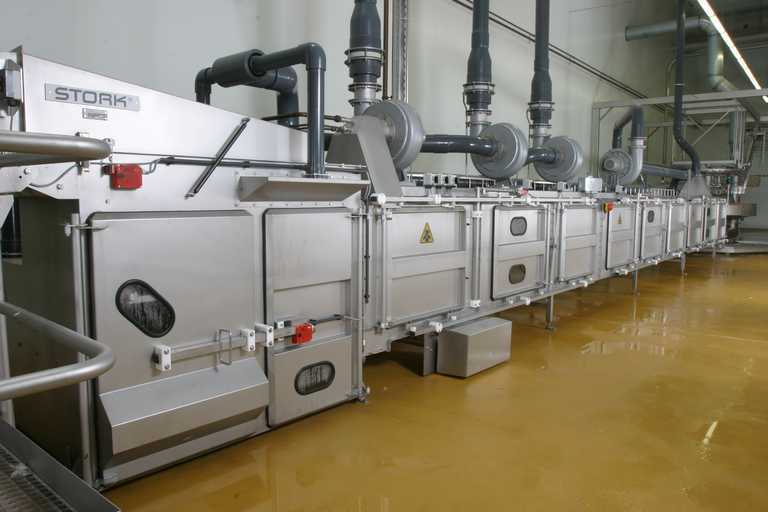The standard in modern poultry processing plants is to render birds insensible—that is, unconscious and incapable of feeling pain—prior to slaughter. The process is known as “stunning.”
There are two basic technological approaches to stunning—electrical stunning and controlled atmospheric stunning. With the former, stunning is achieved by wetting the birds’ heads in water or a mist and creating a mild electrical circuit. Controlled atmospheric stunning achieves insensibility by exposing broilers to either a mixture of inert gases (nitrogen and argon) or concentrations of carbon dioxide. The gas mixture deprives birds of oxygen, causing them to lose consciousness.
Current Practice
 At the present time, most plants that process young chickens for consumption in the United States utilize a low voltage electrical system to stun birds prior to slaughter. A low-voltage electrical current, measured in milliamps, puts the birds in an unconscious state so that they are immobilized and insensible to pain when slaughtered. The systems currently in use are highly effective, with 99 percent of the birds being totally unconscious after the electrical stun, which is administered just prior to slaughter.
At the present time, most plants that process young chickens for consumption in the United States utilize a low voltage electrical system to stun birds prior to slaughter. A low-voltage electrical current, measured in milliamps, puts the birds in an unconscious state so that they are immobilized and insensible to pain when slaughtered. The systems currently in use are highly effective, with 99 percent of the birds being totally unconscious after the electrical stun, which is administered just prior to slaughter.
While the basic process of electrical stunning has been in use for many years, there are many variations on the system. In Europe, processing plants use a high voltage system that stops the bird’s heart rather than merely immobilizing and rendering it insensible to pain, as is done in the U.S. The high voltage systems have to use a much more powerful electrical current to stop the heart, and product quality problems such as hemorrhaging and broken bones can result. For this reason, European processors have been more interested in gas systems, as they would avoid the problems associated with high-voltage stunning. Since high-voltage stunning is not used in the United States, there has been less interest in gas systems.
Animal Welfare Guidelines
The stunning and slaughter process is a very important step in the processing of poultry and should be carefully controlled. Most processing plants in this country are operated by companies that endorse the National Chicken Council’s Animal Welfare Guidelines, which state that stunning and killing equipment should be constantly monitored to insure proper functioning for humane processing. Animal Welfare audits include strict guidelines that routinely monitor the stunning and slaughter equipment to make sure it is working efficiently.
The guidelines state that birds should be insensible to pain when killed; and backup personnel should be employed at the killing station to manually slaughter any bird not properly killed by the equipment.
Humaneness
Electrical stunning has been considered to be humane because it protects the birds from pain at the time of slaughter. Research has established that electrical stunning as practiced in the United States renders the bird insensible to pain. This research showed that the brain waves of stunned animals were flat and they did not respond to stimuli between the stunning and slaughter, indicating that they were indeed unconscious. Based on the fact that the electrical system renders the birds unconscious and insensible to pain before slaughter, it is considered both effective and humane.
Gas Stunning
 “Controlled atmosphere stunning” is a name for the use of carbon dioxide or argon gas as part of the processing of chickens or other poultry for the production of human food. While gas has achieved limited usage in Europe, very few chicken plants in the United States use gas systems.
“Controlled atmosphere stunning” is a name for the use of carbon dioxide or argon gas as part of the processing of chickens or other poultry for the production of human food. While gas has achieved limited usage in Europe, very few chicken plants in the United States use gas systems.
There has been considerable debate over the desirability of different gases and mixtures of gases, even among advocates of gas stunning. Gas systems have to be selected and operated very carefully to avoid undesirable experiences.
Animal Reaction to Gas
While gas stunning or killing is technically feasible, it is not without challenges of its own. Birds subjected to various mixtures of carbon dioxide and argon, the gases most commonly recommended for stunning, will gasp for air and may exhibit behaviors indicating aversion to the gas, including headshaking, wing flapping and convulsions.
Response of Companies to Gas Stunning
Most companies that have looked carefully at the pluses and minuses of gas stunning have concluded that changing to gas stunning is not justified. McDonald’s Corporation conducted a detailed study of the issue and noted, among other things, that “unresolved issues remain for both principal gas mixture types, including the possibility that birds may experience pain or distress before insensibility is achieved.” The study group’s report concluded: “we believe that the application of controlled atmosphere stunning in commercial environments is still in the early stage of development, and therefore, it is premature to make any commitment on future actions at this time.”
What the Experts Say
American Association of Avian Pathologists and the American College of Poultry Veterinarians:
“Controlled atmospheric stunning systems have been demonstrated to be effective for the stunning of commercial poultry, but the overall effect on animal welfare when compared to well-managed electrical stunning systems has not been determined. Improper application of controlled atmosphere systems on poultry can be associated with excitation and injury prior to loss of consciousness and/or incomplete stunning… Research has not consistently demonstrated one commercially available stunning method to be superior to another. Based on current research and evidence available from North American slaughter facilities, it is the position of the AAAP and the ACPV that low voltage and CAS are humane and acceptable methods for stunning of poultry.”
Dr. Yvonne Vizzier Thaxton, Director, Center for Food Animal Wellbeing, University of Arkansas:
“The main animal welfare issue with poultry slaughter is the ability to induce instantaneous insensibility. The requirement is that all animals be insentient when slaughtered. Both electrical stunning and CAS fulfill this requirement when properly administered. We are continually examining potential technologies that may be equal to, or improve upon, those in current use.”
United Nations World Organization for Animal Health (OIE):
At the global level, the United Nations’ OIE — the lead agency for global guidance on animal health and animal welfare policies—has guidelines on humane slaughter. These cover, among other things, uses of electrical stunning and of CAS. The guidelines express no preference for one method over others. Rather they identify, for each method, animal welfare concerns and/or implications and key animal welfare requirements.
Outlook
Given the efficacy of electrical stunning systems and the questions surrounding gas stunning, it is likely that electrical systems will remain standard in the United States. However, the chicken industry is a dynamic one that is open to technological change for animal welfare reasons as well as economic and product quality considerations. The industry will keep an open mind and stay abreast of scientific research that is relevant to conditions in the United States.
To download a copy of this brief, click here.
Additional Reading
American Association of Avian Pathologists Position Statement on Stunning of Poultry
National Chicken Council Animal Welfare Guidelines and Audit Checklist for Broilers



